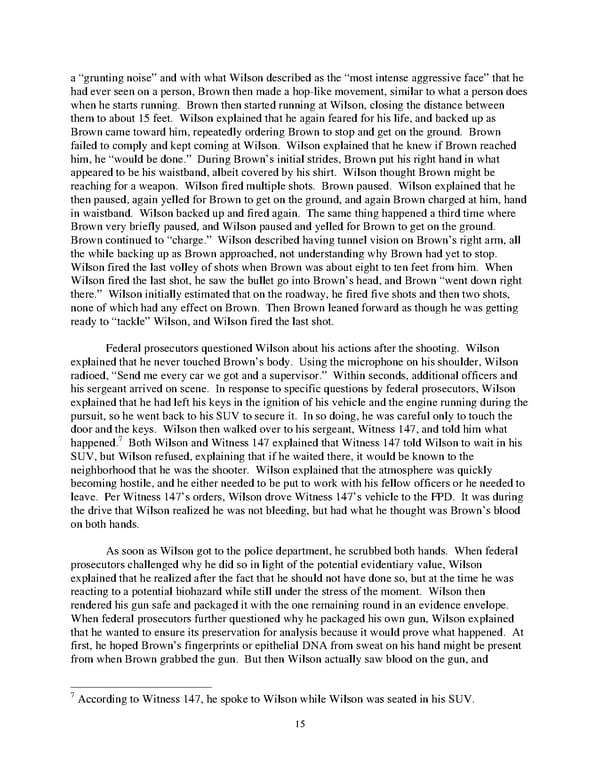a “grunting noise” and with what Wilson described as the “most intense aggressive face” that he ywvutsrponmlihgfedcbaYWVUTSRPONMLJIHGFEDCBA had ever seen on a person, Brown then made a hoplike movement, similar to what a person does when he starts running. Brown then started running at Wilson, closing the distance between them to about 15 feet. Wilson explained that he again feared for his life, and backed up as Brown came toward him, repeatedly ordering Brown to stop and get on the ground. Brown failed to comply and kept coming at Wilson. Wilson explained that he knew if Brown reached him, he “would be done.” During Brown’s initial strides, Brown put his right hand in what appeared to be his waistband, albeit covered by his shirt. Wilson thought Brown might be reaching for a weapon. Wilson fired multiple shots. Brown paused. Wilson explained that he then paused, again yelled for Brown to get on the ground, and again Brown charged at him, hand in waistband. Wilson backed up and fired again. The same thing happened a third time where Brown very briefly paused, and Wilson paused and yelled for Brown to get on the ground. Brown continued to “charge.” Wilson described having tunnel vision on Brown’s right arm, all the while backing up as Brown approached, not understanding why Brown had yet to stop. Wilson fired the last volley of shots when Brown was about eight to ten feet from him. When Wilson fired the last shot, he saw the bullet go into Brown’s head, and Brown “went down right there.” Wilson initially estimated that on the roadway, he fired five shots and then two shots, none of which had any effect on Brown. Then Brown leaned forward as though he was getting ready to “tackle” Wilson, and Wilson fired the last shot. Federal prosecutors questioned Wilson about his actions after the shooting. Wilson explained that he never touched Brown’s body. Using the microphone on his shoulder, Wilson radioed, “Send me every car we got and a supervisor.” Within seconds, additional officers and his sergeant arrived on scene. In response to specific questions by federal prosecutors, Wilson explained that he had left his keys in the ignition of his vehicle and the engine running during the pursuit, so he went back to his SUV to secure it. In so doing, he was careful only to touch the door and the keys. Wilson then walked over to his sergeant, Witness 147, and told him what 7 happened. Both Wilson and Witness 147 explained that Witness 147 told Wilson to wait in his SUV, but Wilson refused, explaining that if he waited there, it would be known to the neighborhood that he was the shooter. Wilson explained that the atmosphere was quickly becoming hostile, and he either needed to be put to work with his fellow officers or he needed to leave. Per Witness 147’s orders, Wilson drove Witness 147’s vehicle to the FPD. It was during the drive that Wilson realized he was not bleeding, but had what he thought was Brown’s blood on both hands. As soon as Wilson got to the police department, he scrubbed both hands. When federal prosecutors challenged why he did so in light of the potential evidentiary value, Wilson explained that he realized after the fact that he should not have done so, but at the time he was reacting to a potential biohazard while still under the stress of the moment. Wilson then rendered his gun safe and packaged it with the one remaining round in an evidence envelope. When federal prosecutors further questioned why he packaged his own gun, Wilson explained that he wanted to ensure its preservation for analysis because it would prove what happened. At first, he hoped Brown’s fingerprints or epithelial DNA from sweat on his hand might be present from when Brown grabbed the gun. But then Wilson actually saw blood on the gun, and 7 According to Witness 147, he spoke to Wilson while Wilson was seated in his SUV. 15
 DOJ Report on Shooting of Michael Brown Page 14 Page 16
DOJ Report on Shooting of Michael Brown Page 14 Page 16